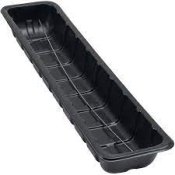FL at CC
Member
Hi everyone!
I’m starting to arrange a slew of prints for an exhibition that will be intended for printing up to 30x40” (I’ve only ever run trays up to 20x24). Can anyone suggest a rig to construct sinks/trays to support 30x40” also how would I easily manage temperature and circulate the solutions for each bath? I’ve heard of some using heat exchangers, aquarium heaters, etc though would appreciate some sound advice.
Good news is that I’m very handy so constructing something from scratch isn’t an issue. More good news is I have my whole loft which can support the large footprint of the large baths.
I’m starting to arrange a slew of prints for an exhibition that will be intended for printing up to 30x40” (I’ve only ever run trays up to 20x24). Can anyone suggest a rig to construct sinks/trays to support 30x40” also how would I easily manage temperature and circulate the solutions for each bath? I’ve heard of some using heat exchangers, aquarium heaters, etc though would appreciate some sound advice.
Good news is that I’m very handy so constructing something from scratch isn’t an issue. More good news is I have my whole loft which can support the large footprint of the large baths.






